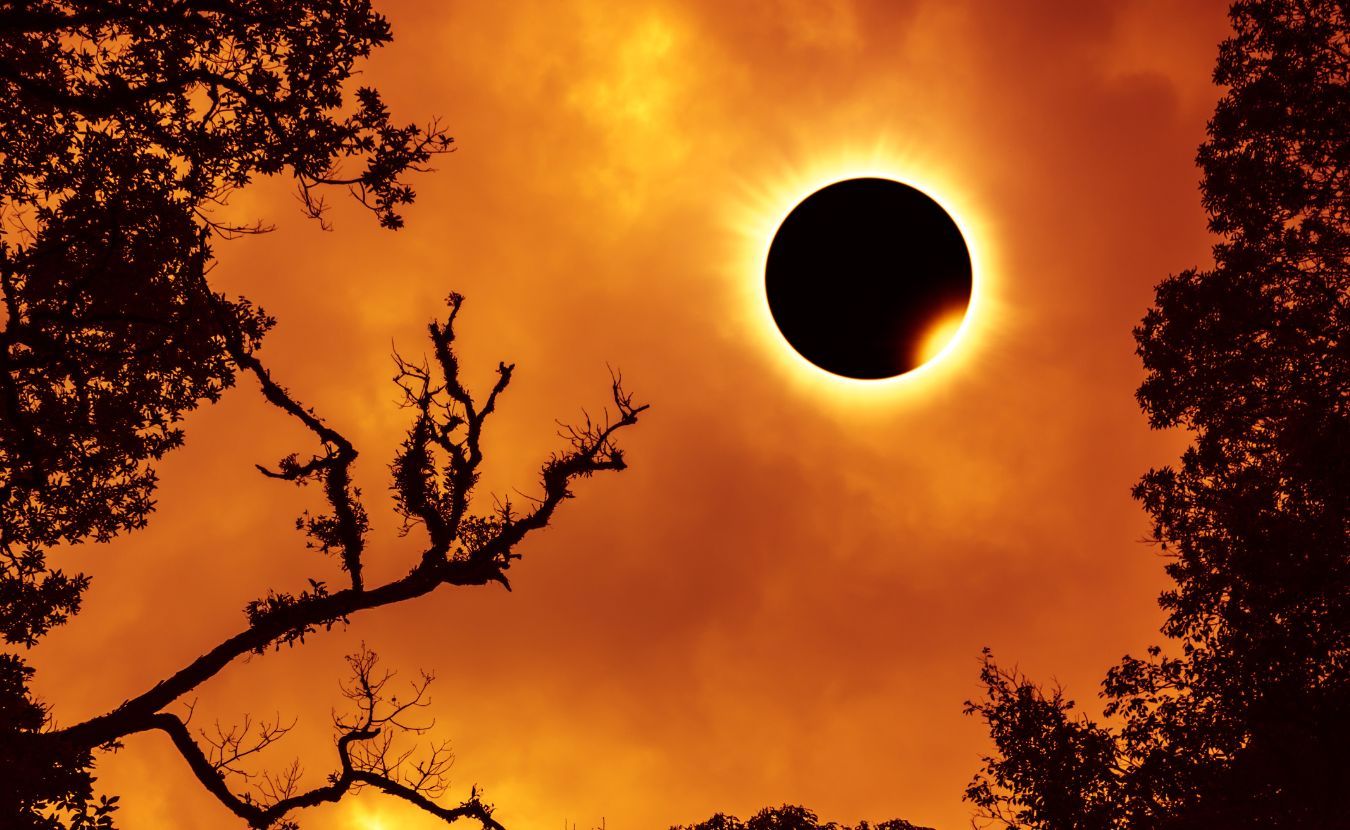“A Total Solar Eclipse will happen on April the 8th, 2024. It will happen with or without human notice. Notice or not-notice is all humans can do.” —Boyd Sturdevant Jr., Grok Art Founder and Art Director
On April 8, 2024, the moon will cross directly between the sun and the earth, obscuring the sun’s rays and casting a shadow on the planet. At its longest, the total solar eclipse will last little more than four minutes, but during that time a swath of the earth’s surface will be blanketed in total daytime darkness.
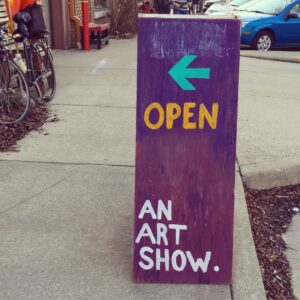 The eclipse on April 8 will enter North America on the Sinaloan shores of Mexico near Mazatlán, pass across the United States from Kerrville, Texas, to Houlton, Maine, make its way over Canada from Niagara Falls to Gander, there finally departing the continent for the Atlantic from the Newfoundland coast. Many locations in the “path of totality” are hosting festivities for locals and eclipse chasers alike.
The eclipse on April 8 will enter North America on the Sinaloan shores of Mexico near Mazatlán, pass across the United States from Kerrville, Texas, to Houlton, Maine, make its way over Canada from Niagara Falls to Gander, there finally departing the continent for the Atlantic from the Newfoundland coast. Many locations in the “path of totality” are hosting festivities for locals and eclipse chasers alike.
In Indiana, the umbral center of the moon’s shadowy path will move northeast from Vincennes and appear in Monroe County about 3 p.m. Bloomington and many of its neighboring communities are preparing for a rush of activity, with some anticipating hundreds of thousands of visitors and locals to gather in celebration of the solar spectacle.
And of course, it wouldn’t be a Bloomington spectacle if art wasn’t involved. Among the many events planned (see a list below), two local artists have been preparing for this moment for more than a year.
‘Sun Moon Earth Memory’
A piece of dusty ash-colored canvas lies on the limestone-powdered floor of the mill of Bybee Stone Company in Ellettsville. The dark outline of Monroe County is sketched onto its surface, the template for a carving-in-progress. Boyd Sturdevant, a healthcare professional with an extracurricular passion for art, and his cousin Ned Cunningham, a six-years-retired master carver at Bybee, tool away under their hardhats amid the squeal and percussive buzz of steel on stone within the cathedralesque mill. The sketch of the county is reflected atop four thick, domed slabs of limestone slightly larger around than a manhole cover and about 6 or 8 inches thick, chiseled with deft precision by air-compressed tools in Cunningham’s well-weathered hands.
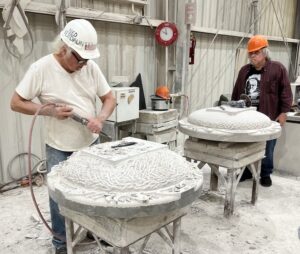
Ned Cunningham (left), a six-years-retired master stone carver, and Boyd Sturdevant work on their project in the mill at Bybee Stone Company in Ellettsville. Cunningham is carving one of the four sculptures they are producing to commemorate the total eclipse in April. Tap or click the photo to watch a short video on YouTube of Cunningham carving the limestone. | Limestone Post
These carvings, conceptualized by Sturdevant and given form by Cunningham, are in honor and recognition of the solar eclipse occurring on April 8. The domed face of each sculpture represents the moon, with Monroe County resting atop the smooth surface. An intricate pattern weaves around the edge of each carving, the sun’s blossoming corona much like the one that will be visible outside the shadow of the moon during the totality of the eclipse. (But remember! You should still wear protective eclipse glasses while watching the eclipse, even during the moments of most coverage.) Sturdevant calls the project Sun Moon Earth Memory, and it’s his attempt to notice — to anticipate, prepare for, and remember the event with others.
Sturdevant writes: “The Sun Moon Earth Memory limestone markers will be crafted by the community and placed close to the umbra centerline in Monroe County, Indiana. The markers are designed to be a point of celebratory notice today — and to be accurately interpreted 1,000 years from now.”
“The goal is to involve a lot of people,” Sturdevant says. “And to honor something outside of us.” Sturdevant wants to create something the public can interact with and remember twenty years later. His intention is that spectators become participants. Whether during a sculpture’s installation at a specific site or on their own time later, people are invited to tap and chip on the limestone, leaving their own mark for history’s records. It’s his wish that in time a passerby might come across the weathered sculpture and recollect the occasion of its crafting. Sturdevant described it with excitement: “Someone might come along and say, ‘Hey, I chipped on that stone.’ Or a child might show their friends and say, ‘Hey, my grandpa helped make that.’”

(l-r) Sturdevant’s sketchbook and some of Cunningham’s tools, a canvas model for the carvings, and two of the works in progress. | Limestone Post
But Sturdevant maintains that this community artwork, and the solar eclipse it represents, are both far outside of and separate from any of us. These solar bodies are indifferent to our upturned eyes, and the moment will not linger just for us. “This don’t care about me,” Sturdevant says, in reference to the impermanence of the eclipse. “So I must either pay attention and recognize it — or not.” Sturdevant hopes the community will also engage in recognizing the unique beauty of the eclipse. And perhaps Sun Moon Earth Memory is just the type of collaborative commemoration to accomplish that.

Cunningham (left) and Sturdevant share a laugh at the Bybee stone mill. | Limestone Post
“I try to take big topics and make stuff to engage people,” Sturdevant says. He’s made the practice of social art his hobby. “A group of people took effort to say, ‘Something happened here,’” Sturdevant says of his vision for his project. He fancies that perhaps even far-future archaeologists will unearth one of the sculptures. “They’ll find a big stone in the ground,” he conjectures. “‘Why is that there?’ they’ll wonder. ‘Oh. They were celebrating.’”
“That’s the stuff myths are made of,” he says.
Though Sturdevant conceptualized Sun Moon Earth Memory, he enlisted the skilled labor of Cunningham to realize the physical aspect of the project. “I love the problem-solving in stone carving,” says Cunningham. “When I was doing it for a living I enjoyed it, and I enjoy it now as part of a sort of mysterious process that we’re going through to make this thing happen.”
Sturdevant and Cunningham clearly spark one another’s joy and creative juices. Demonstrating the process of carving the sculptures during our interview at the stone mill, they worked together with intuitive fluidity. “Boyd was sort of my big brother growing up,” Cunningham says. “He got me making car models when I was a little boy and so I became a thing-maker then through him. So I’m doing it because I love working in limestone and doing sculpture, but I also do it out of love for Boyd and my community.”
In the ’70s, Cunningham worked as a figure model at Rhode Island School of Design. A stone sculpture professor took notice of a clay model Cunningham had made of his girlfriend on his own time and, acknowledging Cunningham’s strong sense of form, encouraged him to enroll in his summer course. Cunningham now recollects the conversation. “Well … I’m staff, I’m not a student,” he told the professor. “I can’t afford your course.” But the instructor insisted that Cunningham come and participate anyway. “So the first time I put a chisel in the stone it was like ‘OK, this is what I want to study,’” Cunningham says. “And being a figure model, I wanted to do it with the subject matter as the figure. And I’m still doing that roughly 50 years later.”
“I first hallucinate the object in the stone,” Cunningham says. He then “carves the void,” leaving only that which he first envisioned — a practice he describes as subtractive carving.

(l-r) The original uncut block of stone, preparing the stone for the saw, and the four cut slabs ready for the carver. | Photos by Boyd Sturdevant
Sturdevant’s art practice makes objects that inspire thought, conversation, and playful imagination around major social, historical, and symbolic events. Cunningham’s art brings those concepts to life. Their hope is that Sun Moon Earth Memory is a gift both from and to the community.
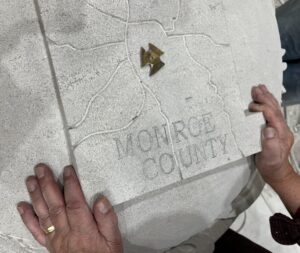
Each stone will show the path of the eclipse as it traverses Monroe County. | Limestone Post
Cut with a belt saw from a solid column of limestone, each of the four sculptures weighs approximately 500 pounds and takes Cunningham about 20 to 25 hours to complete. Cunningham first pitched the idea to George Bybee, vice president at Bybee Stone Company. The stone mill donated the use of its site and machinery, as well as the cut discs, for the project, which is otherwise non-funded. For Sturdevant and Cunningham, this is a passion project. This collaboration between cousins marks a permanent moment in time — one of seemingly great consequence for our community — while recognizing the indifferent passage of time and what we may do to lay a token down for future generations.
During the interview at the Bybee stone mill, the two cousins became sentimentally reminiscent of their childhood in Bloomington, growing up in the neighborhood south of Wylie House. All those years ago, it was abandoned and overgrown with vines and weeds. To me it seemed a poignant example of the impermanence of time, how places and memories shift within us and without us. Their conversation danced with ideas of radiant beauty hidden in shadow, glistening at the edges like beads of sunlight behind the moon. In their humble honor of April’s eclipse, the two cousins have harbored a space for attentiveness, awareness, and remembrance.
“I hope more and more people become personally invested in the project,” Sturdevant says.
“I think there’ll be a part two to this story,” Cunningham replies.
Sturdevant agrees. “Because it’s an ongoing thing,” he says. “We haven’t emerged back to the real world yet. We’re still on the journey.” He turns to his kid cousin. “And it’s been good to reconnect and be on our journey together. It’s been a wonderful thing for us.”
The cousins are looking for permanent homes for each sculpture. So far, one sculpture has been accepted by the Lake Lemon Conservancy District and another by the I Fell Gallery in Bloomington. And both of these locations have their own events planned for April’s total eclipse.
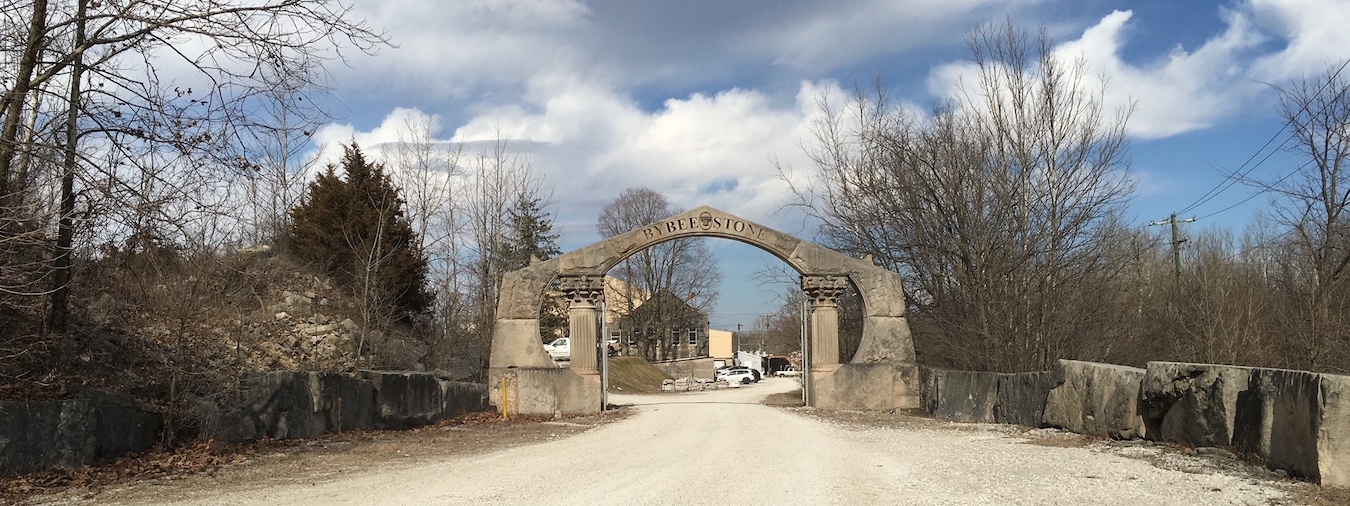
The Bybee Stone Company in Ellettsville donated space in its mill and use of some machinery, as well as the cut discs, for Cunningham and Sturdevant to work on ‘Sun Moon Earth Memory.’ | Limestone Post
Lake Lemon
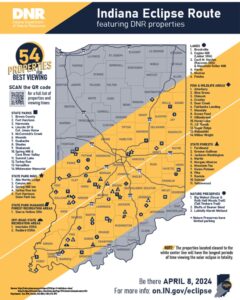
Lake Lemon is directly in the path of totality. Find the Indiana Eclipse Route at visitindiana.com/eclipse2024/.
Adam Casey is the district manager of the Lake Lemon Conservancy District, established in 1995 to maintain the water quality and recreational potential of Lake Lemon. For the eclipse, the LLCD is hosting a two-night camping event with live music, art, and activities for families and children at its beautiful camping area by the lake — which is, of course, completely within the path of totality. The event, in part, is to raise funds for LLCD to continue its preservation of the Lake Lemon natural area. But Casey says the camping experience will also “encourage people to get out in nature with no buildings nearby” so they may fully appreciate the reflection of the eclipse upon the lake water.
“We’re not sold out yet,” Casey said. “We have 300 primitive camping sites and 25 primitive RV sites. There are no hookups and there is still availability.” Go to lakelemon.org for more details.
“We’re extremely excited to be working with a local Lake Lemon resident on an art installation project,” said Casey. He was referring, of course, to Boyd Sturdevant. LLCD plans to install one of Sturdevant and Cunningham’s eclipse carvings at the site. “It will have a permanent base, with landscaping surrounding the sculpture,” said Casey. “This will give attendees a hands-on experience and a chance to put their personal touch [on the artwork],” he said. “They’ll be chipping out the stars or hammering away at the moon.” This encapsulates Sturdevant’s vision for the project, letting participants make their own lasting impact on a significant and memorable local event.
“Our event,” Casey said, “commemorates a specific time and place.” And with the limestone marker in place, campers and visitors to Lake Lemon will be able to witness the evolution of the carving over time, and to remember the eclipse that inspired it all.
I Fell Gallery
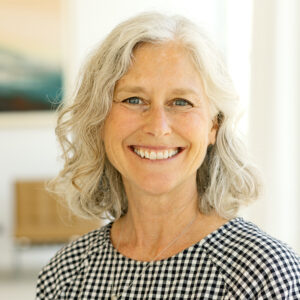
Angela Caldwell, a resident artist at the I Fell Gallery, says one of Sturdevant and Cunningham’s ‘Sun Moon Earth Memory’ carvings will be included in a curated exhibition of local artists at the I Fell. | Courtesy photo
Crafters and curators all through Bloomington are springing into action with the upcoming eclipse, creating art and providing spaces to enjoy it. Angela Caldwell, a resident artist at the I Fell Gallery, located at 415 W. 4th St. in Bloomington, issued a call out for a curated exhibition of local artists for the eclipse event. Advertising through socials and with support from the Bloomington Arts Commission, the Fell has attracted numerous makers, crafters, and performers for its exhibition. The show will offer a perspective on, as Caldwell says, “how local artists interpret the eclipse event.”
Speaking to her in the months before the eclipse, I got a good idea of the excitement and energy already buzzing in Bloomington in anticipation of April’s big day. “We received several submissions from local artists,” Caldwell said. “So we’re accepting one piece from anyone who submitted. This is a full-on community event.”
Caldwell emphasized that she’s happy the idea “got some legs and came to fruition.” The gallery accepted Sturdevant’s submission and will be featuring one of the Sun Moon Earth Memory carvings. Sturdevant’s central idea remains true with Caldwell. “We’ll get the community to chip away on the piece,” she said. The gallery plans to install the sculpture for long-term display inside near the garage doors.
“We wanted to focus on unknown and emerging artists who are interested in the eclipse topic,” Caldwell said. The exhibition will include an eclipse-inspired belt buckle by an IU grad student and will also feature art by local painter Ransom Haile. And Caldwell has her fingers crossed that a collaboration between the IU Eskenazi Museum of Art and the IU Jacobs School of Music, a performance piece with accompanying video art, will come together to be shown at the exhibition.
Other events around town
Ample opportunities for fun here in Bloomington will keep the influx of skywatchers occupied and entertained leading up to and during the day of the eclipse. Visit Bloomington’s eclipse page offers both an itinerary of events and a detailed map of the region.
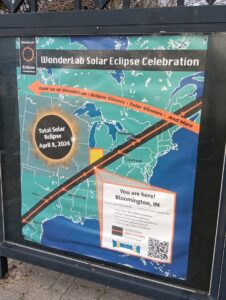
Many places around town will be holding events, including WonderLab, which will be hosting safety and education events. | Photo by Dason Anderson
WonderLab, Bloomington’s beloved downtown children’s science museum, will be hosting safety and education events while offering fun eclipse-themed products for sale.
Both Butler Winery and Oliver Winery will offer a space for eclipse sips, Switchyard Park is facilitating live music (and multiple days’ worth of other activities through the city’s parks and recreation department), and both Fowler Pumpkin Patch and Paynetown SRA are hosting viewing parties.
But wait, there’s more! Bloomington’s festivities will include the presence of one whose fame extends into the cold frontier of space itself. Acclaimed actor William Shatner will be accompanied by Grammy Award-nominated singer, songwriter, and actress Janelle Monáe for the Hoosier Cosmic Celebration at IU Memorial Stadium from 1 to 5 p.m. on April 8. Before Shatner takes the stage for his vocal performance, former NASA astronaut and the first woman of color to travel in space, Dr. Mae Jemison, will deliver a brief speech. The Hoosier Cosmic Celebration will also include performances from the IU Marching Hundred, the IU Contemporary Dance Program, and the Jacobs School of Music. Food trucks and recreation activities will attract students to Dunn Meadow during the day, and the IU Cinema is hosting a sold-out showing of William Shatner: You Can Call Me Bill, a documentary about the space-faring cultural icon who will be in attendance with director Alexandre O. Philippe.
Although the long-planned ShadowFest at the Monroe County Fairgrounds has been recently canceled, the fairgrounds will offer camping and viewing.
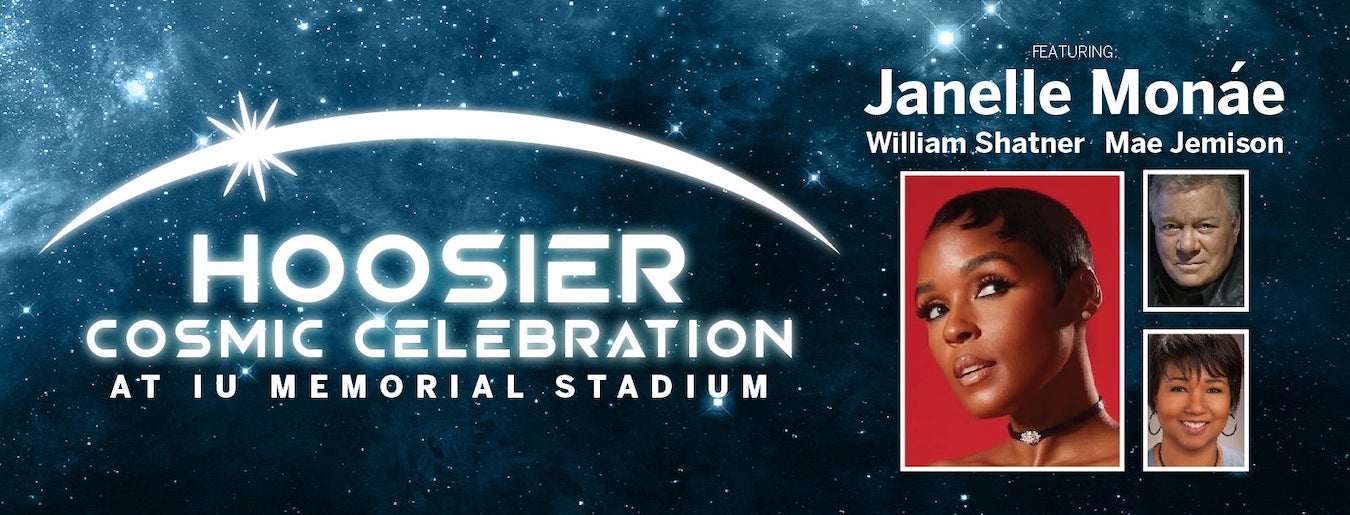
Janelle Monáe, Dr. Mae Jemison, and William Shatner will be at the Hoosier Cosmic Celebration at IU Memorial Stadium from 1 to 5 p.m. on April 8.
Beyond Monroe County
Bloomington isn’t the only Indiana place celebrating the eclipse. The event could bring 600,000 visitors to Indiana, according to the Indiana Capital Chronicle. Many communities in the region fall under the path of totality, and towns from Vincennes to Richmond are preparing for the influx of solar viewers and gearing up with celebrations, festivities, and educational opportunities.
The Lawrence County Fairgrounds will feature four days of camping, carnival rides, live performances, and concessions. Multiple other organizations in the county are offering primitive camping locations as well. State parks and town squares across Indiana will be buzzing with eclipse activity come April.
I spoke with Hannah Jones, the Eclipse Liaison at IU’s Center for Rural Engagement, about the need-to-know info on all of April’s upcoming events. The center, supported by funding from the Simons Foundation in accordance with its In the Path of Totality initiative, is giving support and resources to 30 rural organizations across Indiana in promotion of their solar eclipse arts and cultural activities. Whether you’re exploring the Morgan County Art Sanctuary’s eclipse exhibition, enjoying a drag show at the historic Tivoli Theatre with Spencer Pride, hiking with the Indiana Forest Alliance at Yellowwood State Forest, or simply lounging in your own backyard, you’ll be a part of the hundreds of thousands of Hoosiers who are predicted to participate on eclipse day.
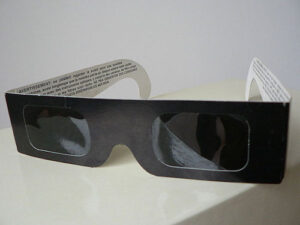
It is dangerous to look at the sun during a partial eclipse, so make sure you have solar eclipse glasses with a designated ISO 12312-2 international standard. | Photo by Bree~commonswiki, Creative Commons
I asked Jones a question perhaps many of us share: Where can I get my eclipse-viewing glasses? She had a swift answer. “Our recommendation is to refer to the American Astrological Society’s list of suppliers of safe solar filters and viewers (i.e., products that meet the ISO 12312-2 international standard),” she said via email. “It is crucial to ensure that the eclipse glasses and viewers you order are coming from a reputable source, and that you order them soon! More information about eye safety and ways to view the eclipse can be found in our 2024 Total Solar Eclipse Planning Toolkit.” A number of vendors in Bloomington also offer eclipse glasses, including Bloomingfoods, Wild Birds Unlimited, and the Parks and Recreation office inside city hall.
Next, I asked Jones if she is aware of anywhere in the area that will be particularly good for viewing the eclipse. “This answer may come as a surprise,” she said, “but if you live in the path of totality, the best place to view the eclipse is likely your own backyard. With the anticipated crowds, traffic, and other potential strains on local infrastructure, staying home will save you the hassle and ensure more resources remain available for visitors. Just make sure you have a clear sightline to where the sun and moon will align!”
“But,” she continued, “if you’re looking for a specific event or eclipse viewing party, I recommend browsing the list of microgrant-funded events on our website or exploring the Visit Indiana Eclipse Route map. Here you’ll find unique events ranging from festivals to campsites, spanning across the path of totality.”
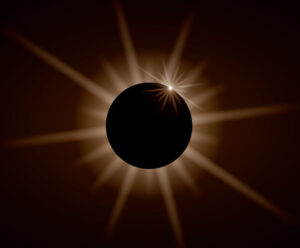
After April 8, the next eclipse to put Bloomington in the path of totality will not occur for many generations. | Photo by Drew Rae
I wondered how long some of these events have been in planning, or when organizers first started getting the gears in motion. Jones said that, though interest in the April eclipse has certainly picked up over the past few months, many of the eclipse microgrant-funded organizations have been planning for longer — even years. “There are some cases where communities were able to build off the buzz of the partial 2017 eclipse,” she said. “But there are also organizations that began planning in response to the funding made available by the Simons Foundation through the IU Center for Rural Engagement. It has been exciting to see all the different ways our partner organizations use this opportunity to catalyze arts and culture engagement in rural Indiana communities.”
I know that April 2024’s total eclipse will be a memorable and impactful spectacle for Hoosiers here in southern Indiana — and for those visiting from out of town. But I wanted to know how rare and exceptional this event truly is. Will this be a once-in-a-lifetime opportunity for some people? And Jones was excited with her answer. “Yes, it’s very special!” she said. “You might remember the partial solar eclipse in 2017, but the last total solar eclipse to reach Bloomington was back in 1869. And there is a huge difference between experiencing a partial solar eclipse and a total solar eclipse. Unlike in 2017, when totality occurs on April 8, 2024, we’ll see no sunlight at all. And if weather permits (based on historical weather data, we anticipate a 40 percent chance of clear skies), we’ll get to see the corona and prominences of the sun emerge from behind the moon.” This phenomenon creates that iconic, glowing effect we see during a total eclipse.
“Worth note,” she continued, “there is another total solar eclipse crossing over northern Indiana in 2099, but the next to put Bloomington in the path of totality comes about 50 years later, in 2153. Although these solar eclipses are generations apart from the one on April 8, 2024, we’re actually lucky to have so many ‘close’ together in time. To put things into perspective, on average, we’ll see a total solar eclipse in the same area about every 400 years — definitely a once-in-a-lifetime occurrence, no matter where you are!”

